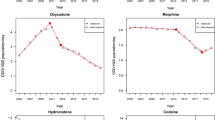Abstract
Objective
To describe trends in opioid consumption in Israel (morphine, methadone, oxycodone, pethidine, fentanyl, buprenorphine, codeine, and dextropropoxyphene) over the 9 years, 2000–2008, and to explore explanations for changes in consumption, in amounts and the pattern.
Methods
Data for the 2000–2008 period (all treatment settings, private and public) were drawn from the database maintained by the Israel Ministry of Health's Pharmaceutical Administration. The data were converted into a defined daily dose (DDD)/1,000 inhabitants/day.
Results
Consumption of the five strong opioids (requiring a special prescription form) increased by 47%, from 2.46 DDD/1,000 inhabitants per day in 2000 to 3.61 DDD/1,000 inhabitants per day in 2008. This rise was mainly the result of a 4-fold increase in fentanyl consumption from 0.32 DDD/1,000 inhabitants per day in 2000 to 1.28 DDD/1,000 inhabitants per day in 2008. Oxycodone and methadone consumption levels increased moderately, and buprenorphine and dextropropoxyphene consumption rose drastically, whereas morphine, pethidine, and codeine use significantly fell.
Conclusion
There has been a modest increase in opioid consumption in the years 2000–2008. This has been associated with substantial changes in the pattern of differential opioid prescribing characterized by increased prescription of oxycodone, fentanyl, buprenorphine, and dextropropoxyphene, and decreases in morphine, pethidine, and codeine.


Similar content being viewed by others
References
Cicero TJ, Inciardi JA, Muñoz A (2005) Trends in abuse of Oxycontin and other opioid analgesics in the United States: 2002–2004. J Pain 6(10):662–672
Cicero TJ, Inciardi JA, Surratt H (2007) Trends in the use and abuse of branded and generic extended release oxycodone and fentanyl products in the United States. Drug Alcohol Depend 91(2–3):115–120
Garcia del Pozo J, Carvajal A, Viloria JM, Velasco A, Garcia del Pozo V (2008) Trends in the consumption of opioid analgesics in Spain. Higher increases as fentanyl replaces morphine. Eur J Clin Pharmacol 64(4):411–415
Polomano RC, Rathmell JP, Krenzischek DA, Dunwoody CJ (2008) Emerging trends and new approaches to acute pain management. J Perianesth Nurs 23 [1 Suppl]:S43–S53
Hamunen K, Paakkari P, Kalso E (2009) Trends in opioid consumption in the Nordic countries 2002–2006. Eur J Pain 13(9):954–962
Spiller H, Lorenz DJ, Bailey EJ, Dart RC (2009) Epidemiological trends in abuse and misuse of prescription opioids. J Addict Dis 28(2):130–136
De Leon-Casasola OA (2008) Current developments in opioid therapy for management of cancer pain. Clin J Pain 24 [Suppl 10]:S3–S7
Heitz JW, Witkowski TA, Viscusi ER (2009) New and emerging analgesics and analgesic technologies for acute pain management. Curr Opin Anaesthesiol 22(5):608–617
Van Zee A (2009) The promotion and marketing of oxycontin: commercial triumph, public health tragedy. Am J Public Health 99(2):221–227
Sinatra R (2006) Opioid analgesics in primary care: challenges and new advances in the management of noncancer pain. J Am Board Fam Med 19(2):165–177
Verdoux H, Begaud B (2004) Pharmaco-epidemiology: what do (and don't) we know about utilisation and impact of psychotropic medications in real-life conditions? Br J Psychiatry 185:93–94
WHO Collaborating Centre for Drug Statistics Methodology (1997) Guidelines for Anatomical Therapeutic Chemical (ATC) Classification Research System. WHO Collaborating Centre for Drug Statistics Methodology, Report No. 5. Oslo
Eisenberg E, Adler R (2004) Consumption of opioids in a hospital setting—what can we learn from a 10 year follow-up? Isr Med Assoc J 6(1):19–23
Shvartzman P, Freud T, Singer Y, Brill S, Sherf M, Battat E, Vardy D (2009) Opioid use in an Israeli health maintenance organization: 2000–2006. Pain Med 10(4):702–707
WHO Collaborating Centre for Drug Statistics Methodology (2009) ATC/DDD Index 2010. Available at http://www.whocc.no/atc_ddd_index/. Accessed 25 August 2010
Israel National Cancer Registry (INCR). Annual reports 2000–2006. Available at http://www.health.gov.il/pages/defaut/. Accessed 27 April 2010
Cherny NI, Baselga J, de Conno F, Radbruch L (2010) Formulary availability and regulatory barriers to accessibility of opioids for cancer pain in Europe: a report from the ESMO/EAPC Opioid Policy Initiative. Ann Oncol 21(3):615–626
Ponizovsky AM, Grinshpoon A, Margolis A, Cohen R, Rosca P (2006) Well-being, psychosocial factors, and side-effects among heroin-dependent inpatients after detoxification using buprenorphine versus clonidine. Addict Behav 31(11):2002–2013
Ponizovsky AM, Margolis A, Heled L, Rosca P, Radomislensky I, Grinshpoon A (2010) Improved quality of life, clinical, and psychosocial outcomes among heroin-dependent patients on ambulatory buprenorphine maintenance. Subst Use Misuse 45(1–2):288–313
Acknowledgements
We wish to thank Mr. Israel Fitoussi for providing datasets for this study and Mr. Nahum Steigman for linguistic editing.
Author information
Authors and Affiliations
Corresponding author
Rights and permissions
About this article
Cite this article
Ponizovsky, A.M., Marom, E., Zeldin, A. et al. Trends in opioid analgesics consumption, Israel, 2000–2008. Eur J Clin Pharmacol 67, 165–168 (2011). https://doi.org/10.1007/s00228-010-0932-0
Received:
Accepted:
Published:
Issue Date:
DOI: https://doi.org/10.1007/s00228-010-0932-0




